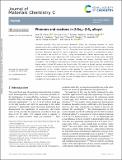Phonons and excitons in ZrSe2–ZrS2 alloys
Author(s)
Oliver, Sean M.; Fox, Joshua J.; Hashemi, Arsalan; Singh, Akshay k; Cavalero, Randal L.; Yee, Sam; Snyder, David W.; Jaramillo, Rafael; Komsa, Hannu-Pekka; Vora, Patrick M.; ... Show more Show less
DownloadOliver et al. - 2020 - Phonons and Excitons in ZrSe2 - ZrS2 Alloys.pdf (5.826Mb)
Open Access Policy
Open Access Policy
Creative Commons Attribution-Noncommercial-Share Alike
Terms of use
Metadata
Show full item recordAbstract
Zirconium disulfide (ZrS[subscript 2]) and zirconium diselenide (ZrSe[subscript 2]) are promising materials for future optoelectronics due to indirect band gaps in the visible and near-infrared (NIR) spectral regions. Alloying these materials to produce ZrSxSe[subscript 2−x] (x = 0…2) would provide continuous control over key optical and electronic parameters required for device engineering. Here, we present a comprehensive analysis of the phonons and excitons in ZrSxSe[subscript 2−x] using low-temperature Raman spectroscopy and room-temperature spectroscopic ellipsometry (SE) measurements. We extract the Raman-active vibrational mode frequencies and find that they compare favorably with density functional theory (DFT) calculations. Our simulations and polarization-resolved measurements demonstrate that substitutional doping renders infrared (IR) modes to be Raman-active. This leads to a Raman spectrum dominated by nominally IR phonons, a phenomenon that originates from the large ionicity of the ZrSxSe[subscript 2−x] bonds. SE measurements of the complex refractive index quantify the blue-shift of direct, allowed exciton transitions with increasing S content, and we find strong light–matter interactions with low optical loss in the NIR. Correlating these data with DFT allows for an estimation of the Γ-point exciton binding energy at room temperature. This study illustrates the large effects of alloying on ZrSxSe[subscript 2−x] and lays the foundation for future applications of this material.
Date issued
2020-03Department
Massachusetts Institute of Technology. Department of Materials Science and EngineeringJournal
Journal of Materials Chemistry C
Publisher
Royal Society of Chemistry (RSC)
Citation
Oliver, Sean M. et al. "Phonons and excitons in ZrSe2–ZrS2 alloys." Journal of Materials Chemistry C 8, 17 (March 2020): 5732-5743 © 2020 Royal Society of Chemistry
Version: Author's final manuscript
ISSN
2050-7526
2050-7534